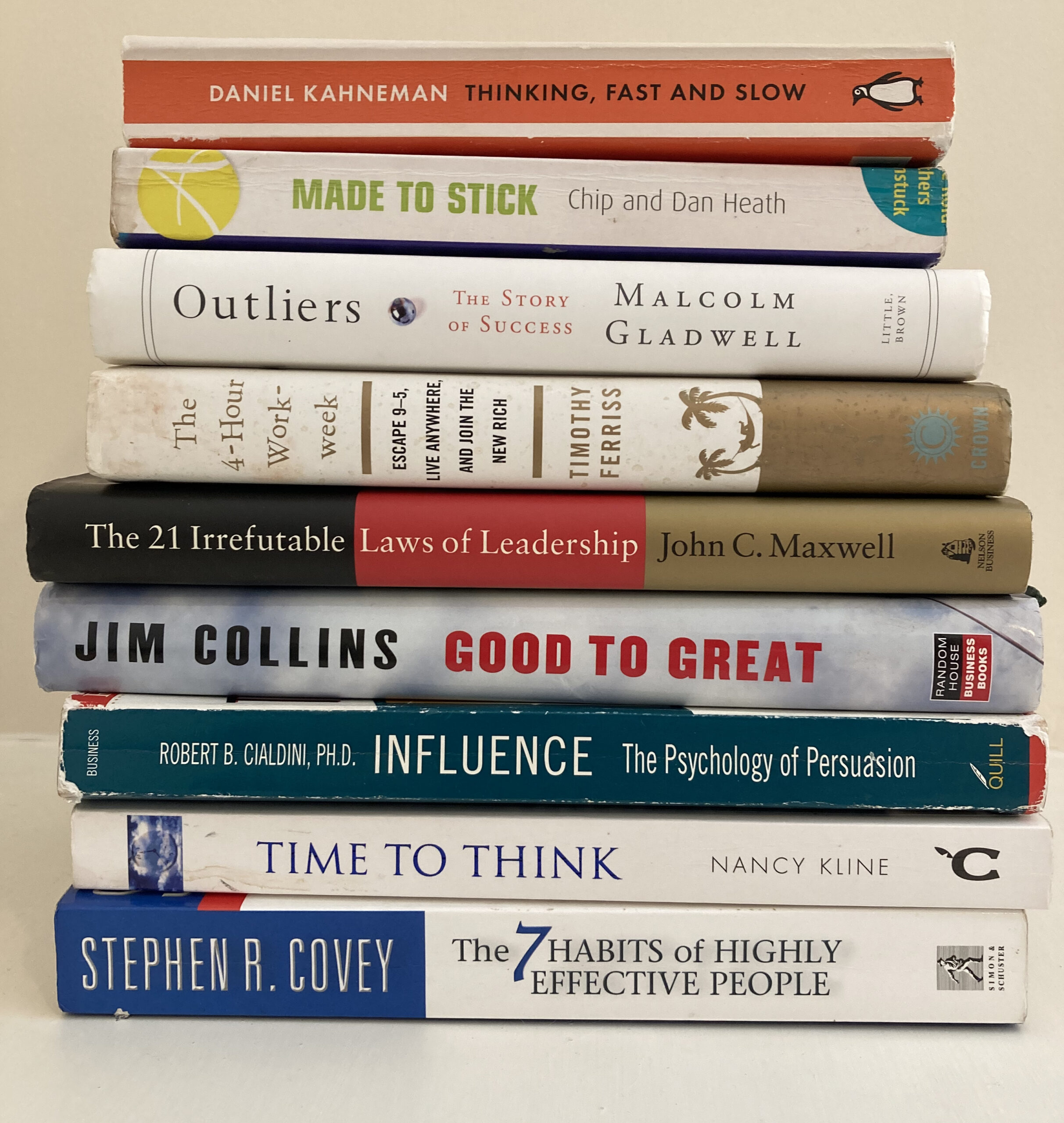9 Best Books on Leadership: Must-Reads to Inspire, Motivate, and Transform Your Team
Leadership isn’t just about holding a position of power; it’s about inspiring and guiding others toward a common goal. Whether you’re a seasoned executive or just starting your leadership journey, the right book can offer invaluable insights and strategies.
In this article, you’ll discover nine of the best books on leadership that can help you refine your skills, motivate your team, and drive success. These handpicked selections cover a range of perspectives and techniques, ensuring you’ll find something that resonates with your leadership style.
1. Start With Why by Simon Sinek
Exploring the Concept of “Why”
Understanding the “why” is crucial for effective leadership. Simon Sinek explores how great leaders inspire action by focusing on the purpose behind their actions. He demonstrates that leaders who start with “why” can better communicate their vision and motivate their teams. Sinek’s concept emphasizes that knowing the reason behind what you’re doing ignites passion and fosters stronger connections.
Impact on Leadership Thinking
“Start With Why” reshapes how you think about leadership by shifting the focus from what you do to why you do it. This approach encourages leaders to inspire rather than manage, creating a more engaged and motivated workforce. The book introduces practical examples, like Apple and Martin Luther King Jr., that illustrate how leading with a strong “why” can drive immense success. It’s a transformative read that challenges you to look deeper into your motivations and influence.
2. The 21 Irrefutable Laws of Leadership by John C. Maxwell
John C. Maxwell is a renowned leadership expert. His book, “The 21 Irrefutable Laws of Leadership,” is a must-read for aspiring leaders.
Overview of the 21 Laws
Maxwell’s book details 21 fundamental principles every leader should understand. Each law is illustrated with real-life examples, making them easily relatable. For instance, the Law of Influence emphasizes that true leadership is measured by influence, not authority. The Law of Process highlights that leadership development is a lifelong journey. Maxwell also dives into the Law of Navigation, which underscores the importance of planning and vision in steering your team to success.
Application in Real-World Scenarios
Maxwell’s laws aren’t just theoretical; they’re actionable. The Law of Respect is key in fostering a positive workplace, encouraging you to build relationships where others naturally follow you. Use the Law of Magnetism to attract individuals who share your vision and values. In corporate settings, the Law of Priorities helps you focus on what’s critical, ensuring efficient time management and goal achievement. Each law provides practical advice you can implement immediately to improve your leadership skills and impact.
3. Lean In: Women, Work, and the Will to Lead by Sheryl Sandberg
Sheryl Sandberg’s “Lean In” offers a powerful perspective on the challenges women face in leadership roles. It provides actionable advice for overcoming these challenges.
Addressing Gender Disparities in Leadership
Sandberg identifies systemic barriers that hold women back from leadership positions. She discusses issues like unequal opportunities, unconscious bias, and work-life balance struggles. Real-life anecdotes and statistical data illustrate these disparities vividly. You’ll find methods to challenge these norms, such as advocating for mentorship and supportive workplace policies.
Key Takeaways for Aspiring Leaders
“Lean In” emphasizes the importance of self-confidence and persistence for aspiring leaders. Sandberg encourages you to seek out leadership roles confidently and negotiate for what you’re worth. Practical advice includes leaning into career opportunities and speaking up in meetings. Sandberg also stresses building a strong support network. Following these principles can empower you to break through barriers and lead effectively.
4. Dare to Lead by Brené Brown
Brené Brown’s “Dare to Lead” delves into the essence of courageous leadership through vulnerability and courage. This book offers practical advice for leaders who aspire to create a culture of trust and innovation.
The Role of Vulnerability in Leadership
Brown emphasizes that vulnerability isn’t a weakness but a strength. Embracing vulnerability allows you to connect with your team on a deeper level, fostering trust and open communication. By sharing your own uncertainties and challenges, you encourage your team to do the same—creating a safe environment where innovation and collaboration can thrive.
Strategies for Courageous Leadership
Brown outlines actionable strategies for leading with courage. First, practice empathy and active listening. Understanding your team members’ perspectives builds respect and loyalty. Second, set clear boundaries while being transparent about expectations. This clarity reduces misunderstandings and aligns team efforts. Lastly, engage in reflective practices to learn from failures and celebrate successes, reinforcing a growth mindset throughout your team.
5. The Five Dysfunctions of a Team by Patrick Lencioni
Patrick Lencioni’s “The Five Dysfunctions of a Team” provides invaluable insights into common pitfalls that can undermine your team’s cohesion and effectiveness. This book is a must-read for anyone looking to transform team dynamics and drive better results.
Identifying Team Dysfunctions
Identifying dysfunctions in your team is crucial to mending inefficiencies. Lencioni outlines five primary dysfunctions: absence of trust, fear of conflict, lack of commitment, avoidance of accountability, and inattention to results. Absence of trust stems from an unwillingness to be vulnerable within the group. Fear of conflict arises when team members avoid healthy debates to sustain artificial harmony. Lack of commitment reflects ambiguous goals and decisions, making it hard for team members to commit fully. Avoidance of accountability means team members hesitate to call out peers on performance or behaviors that could harm the team. Inattention to results occurs when individuals prioritize personal success over team success. Recognizing these dysfunctions helps you address them systematically.
Creating a Thriving Team Environment
Creating a thriving team environment involves fostering trust, encouraging open dialogue, and emphasizing accountability. Begin by building trust through vulnerability, allowing team members to share and collaborate more openly. Facilitate constructive conflict by creating a culture where differing opinions are valued and debated. Foster commitment by ensuring that everyone is clear on goals and their role in achieving them. Promote accountability by setting clear expectations and consequences for underperformance. Finally, focus on collective results by aligning individual goals with team objectives. Implementing these strategies, as Lencioni suggests, can turn dysfunction into function and lead your team to high performance.
6. Good to Great by Jim Collins
Understanding the Good-to-Great Framework
This book identifies why some companies make the leap from good to great while others don’t. Collins introduces the Hedgehog Concept, which encourages focus on what a company does best, what drives their economic engine, and what they are passionate about. You’ll learn about Level 5 Leadership, a blend of personal humility and professional will, crucial for transforming organizations.
Lessons From Companies That Made the Leap
Collins conducted a comprehensive study applying rigorous criteria to identify companies. You’ll see real examples from businesses like Walgreens and Kimberly-Clark, illustrating how disciplined people, thought, and action create sustained success. Good to Great emphasizes investing in the right people and maintaining unwavering focus on the company’s core values.
7. Leadership and Self-Deception by The Arbinger Institute
“Leadership and Self-Deception” delves into how self-deception can hinder effective leadership.
Exploring Self-Deception in Leadership
Discover how self-deception creates barriers. The book reveals how leaders often deny their impact on team dynamics, leading to poor decisions. It explains that when leaders deceive themselves, they undermine trust and collaboration. By recognizing these patterns, you can start making more honest, effective choices. For example, understanding why you may blame others instead of addressing your own failures can transform your leadership style.
Tools for Better Self-Awareness
Learn practical tools to improve self-awareness. The Arbinger Institute offers strategies that help you see beyond your biases. Techniques such as focusing on outward mindset rather than inner preoccupations encourage leaders to consider others’ needs. The book emphasizes reflecting on your behavior’s impact on others, promoting a healthier, more productive environment. For instance, actively seeking feedback from your team can provide insights that challenge your assumptions, fostering better leadership practices.
8. Drive: The Surprising Truth About What Motivates Us by Daniel H. Pink
Daniel H. Pink’s “Drive” explores the science behind motivation, debunking traditional carrot-and-stick methods. This insightful book shows how intrinsic motivation drives peak performance.
Revising Motivational Techniques
Understand that traditional motivators like rewards and punishments often fail. Pink argues that autonomy, mastery, and purpose are crucial. Research indicates these elements foster greater engagement and productivity. Think about how offering autonomy can lead to innovative solutions, as seen in companies like Google with their 20% Time policy. Ensure your team’s tasks align with their strengths and passions to see a significant boost in motivation.
Applying New Strategies to Inspire Teams
Implement strategies that prioritize intrinsic motivation. Encourage autonomy by giving team members more control over their projects. Foster mastery by providing opportunities for skills development through workshops or training programs. Emphasize purpose by clearly linking individual roles to broader organizational goals. Zappos, for instance, creates a culture of purpose by empowering employees to deliver “WOW” through service, illustrating the power of intrinsic motivators in action.
9. The Leader Who Had No Title by Robin Sharma
Robin Sharma’s “The Leader Who Had No Title” offers powerful insights into leading without formal authority. The book is a compelling read that equips everyday individuals with the mindset to become true leaders in their spheres.
Leadership Without Formal Authority
Sharma illustrates how anyone can lead, regardless of their position. He uses relatable characters and real-world scenarios to demonstrate leadership without a title. You can make a significant impact in your organization by embracing this mentality and focusing on influencing others through your actions and integrity.
Principles for Everyday Leaders
Sharma lays out several principles to guide everyday leaders. One key principle is to innovate continuously, which means staying creative and proactive in your work. Another is to build genuine relationships, offering trust and support to your colleagues. These principles help create a positive work environment and foster a culture of collective leadership.
Conclusion: Integrating Leadership Lessons
The journey through these nine books offers a comprehensive roadmap for becoming an effective leader. Each book provides unique insights and actionable strategies that can transform your leadership style and enhance team dynamics. By integrating these lessons, you’ll not only inspire and motivate your team but also foster an environment of trust and innovation.
Embrace the principles of autonomy, purpose, and mastery to drive performance, and remember that leadership isn’t confined to titles. Your ability to lead with integrity and influence others through your actions is paramount. Dive into these books and start your journey towards exceptional leadership today.






